Asus G60J – 16.5in Gaming Laptop Review
Asus G60J – 16.5in Gaming Laptop
We check out the second mobile Core i7 gaming laptop to pass through our labs, offering niceties such as a backlit keyboard and EAX Advanced HD 4 sound.
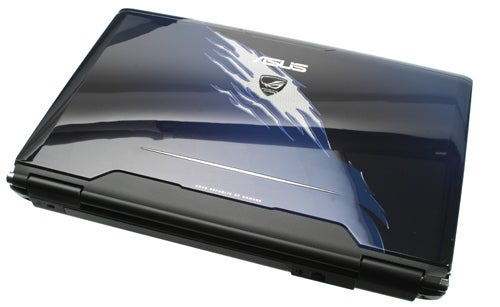
Verdict
Key Specifications
- Review Price: £1540.57
Gaming laptops are all about compromise. Manufacturers have to carefully juggle size and weight with price and performance, and inevitably these mobile monsters end up being large, heavy, expensive and – compared to even mid-range desktop rigs – underpowered. However, anyone who changes accommodation regularly or who’s tried lugging their full tower desktop to a LAN party will know that gaming laptops do have their place. Join us as we find out whether Asus’ new Core i7 G60J has what it takes.
Initial impressions are quite good, with the lid finding a nice balance between the plain glossy black often found on third-party gaming chassis and the brazen bling many other gaming laptops too frequently employ. 
What you get here is an arresting but classy blue and white flame pattern against a blue-black gradient background, with the embossed transparent Republic of Gamers logo a definite highlight. Unfortunately this glossy finish is just as enamoured of fingerprints as most, so you’ll need to regularly use the included cleaning cloth (or a sleeve) to keep the machine looking at its best.
Thankfully, on the inside the only glossy areas are the screen bezel and keyboard surround, with the palm-rest coated in lovely soft-touch plastic, and a smooth, matt touchpad. This is nicely complemented by white-backlit status icons below the hinge and the touchpad’s brushed metal surround.
With its 16in screen the G60J is more compact than some of the behemoths we get through the office, but at over 4cm thick and 3.3kg with battery it’s certainly no lightweight. Build quality is generally decent enough with the exception of the hinge, which feels somewhat loose and creaks in action. 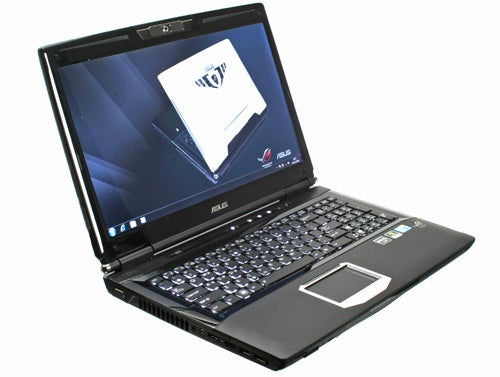
Asus has gone for its usual isolation (or chicklet)-style keyboard. Layout is pretty much spot on and there’s a full number pad included, and keys have a comfortable matt surface and are well-spaced. It does, however, have a US layout so has an elongated left Shift and a half height Enter key, which UK users may find annoying.
Feedback isn’t all that great either with rather shallow travel and severe flex if keys are pressed with any force. There’s also a hint of rattle, though with a game or film on you really won’t notice the noise. For gaming this keyboard is by no means a competitor to the Logitech G13 Gameboard, but on the other hand it lacks obvious defects and will get the job done
Although regrettably there are no gaming keys (a welcome innovation found on the Rock Xtreme 840SLI), the G60J’s entire keyboard is backlit in white, perfect for in those late-night gaming sessions. A light sensor will switch this feature on automatically when required, though there are also three manual settings – or you can just switch it off altogether to preserve battery life. It’s a great implementation, and a feature that should be standard on all gaming laptops.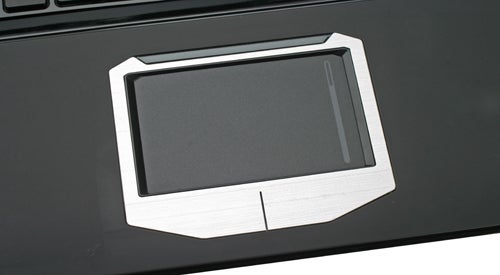
The large touchpad is responsive and generally a pleasure to use. Its twin buttons are incorporated into the metal touchpad- surround and separated by an etched line, and provide decent enough feedback though they’re a tad on the stiff side.
Getting onto connectivity, Asus’ G60J gaming laptop leaves you wanting for very little. At the back are the power and Gigabit Ethernet sockets. On the left we have VGA and HDMI video outputs, together with two USB ports, a 54mm ExpressCard slot, a mini FireWire connection and eSATA. 
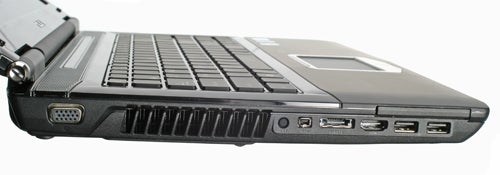
At the front you’ll find an SD/HC/xD/MS memory card reader, along with more status icons (which can be seen with the lid closed) and a wireless switch. Finally on the right you’ll encounter a further two USB ports, three 3.5mm audio jacks for digital or analogue surround sound and a Blu-ray drive to play back the latest high definition films.
Not that the 16.5in screen will let you enjoy them in their native Full HD glory though, as the G60J comes with a disappointingly low resolution 1,366 x 768 display. The advantage to this is that the laptop’s single nVidia GeForce GTX 260M video card will be able to run advanced games like Crysis on higher detail settings at the screen’s native resolution, but of course you do sacrifice desktop real estate. We would say it’s a logical compromise, but it’s a shame that a machine costing well over £1,000 requires it – still, that’s mobile PC gaming for you. 
Anyway, as reflective laptop screens go this example puts in a decent performance. There’s little sign of backlight bleed (only a slight hint is visible from the right side towards the top, not along the bottom as usual and therefore less intrusive during films especially), minimal banding, and good sharpness.
Tonal performance and contrast are also quite good, though with one major caveat: this screen suffers from marked contrast shift depending on viewing angle, so to get subtle bright and dark detail simultaneously you’ll have to get the angle just right, something that’s by no means easy. Still, overall it will do for both work and entertainment, and most importantly it will let you see all the monsters in dark games like Doom 3.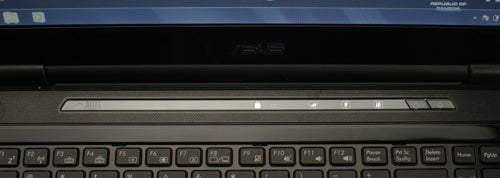
Unfortunately the Altec Lansing speakers leave us less impressed than we had hoped. Though the audio they produce is clear and has no trouble coping with detailed, subtle trebles, their utter lack of bass and low maximum volume fail to do any justice to the world-first sound card the G60J brings to the table.
You see, the G60J is the “the world’s first notebook to support 3D gaming surround audio in the form of EAX Advanced HD 4.0 audio technology” according to Asus. Considering this is the same effects-set as found on Creative’s X-Fi sound cards (probably the most popular high-end gaming audio card around), there are loads of titles that support it, so it should provide genuine enhancement for your gaming.
The rest of the G60J’s internals are no less impressive, led by an Intel mobile Core i7 quad-core processor. The 720QM might be the ‘slowest’ i7 model out there, running at a relatively pedestrian 1.6GHz, but thanks to its 6MB cache and architectural enhancements – not to mention the ability to turbo-clock all the way up to 2.8GHz on a single core – it’s more than capable of beating most Core 2 CPUs (as we saw in the Novatech X70 CA Pro review where it left a 3.06GHz Intel Core 2 Extreme X9100 in the dust).
This is backed by 4GB of 1,066MHz DDR3 RAM, which is pretty much standard across desktops and laptops these days and will be fully utilised by a 64-bit version of Windows. 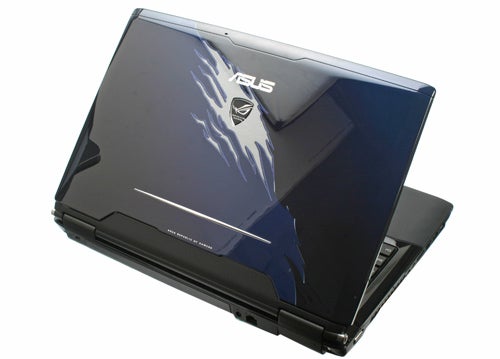
Anything but standard is this laptop’s permanent storage though, as you get a full terabyte (1TB) of hard drive space courtesy of twin 500GB drives running at a speedy 7,200rpm. To have this configuration as standard is fairly rare and certainly appreciated. Asus doesn’t skimp on wireless connectivity either, as you not only get the Wi-Fi N almost ubiquitous on high-end laptops but also Bluetooth 2.1 plus EDR, an option that’s often left out to cut costs.
So far it’s all very impressive but the single most important element of any gaming laptop are its graphics, and this is the one area where the G60J disappoints ever so slightly. Instead of the nVidia GeForce GTX 280M we would expect to find on such a well-specified mobile gaming machine, we have a GTX 260M running the show instead (and this would appear to be the highest card offered on any Asus gaming laptop in the UK). 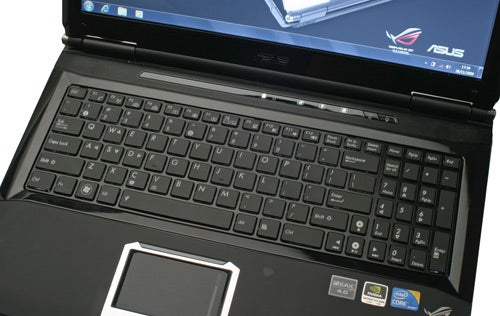
This means you get 112 processing cores instead of the GTX 280M’s 118 and a 100MHz decrease in core clockspeed, though with everything else (including memory speed and bandwidth) the same there shouldn’t be too much performance difference.
Indeed, even at 1,366 x 768 Crysis only ran at a just about playable 25fps average on High Detail. To be fair to the G60J though, Crysis is still one of the most demanding games out there, and Call of Duty 4 ran at a silky-smooth 75fps average with everything turned up to maximum. To put this card’s performance into context with the graphical prowess of most mainstream laptops (which use Intel’s integrated graphics), in TrackMania Nations Forever where the latter manage about 16fps at best, the GTX 260 returned a figure of 148fps!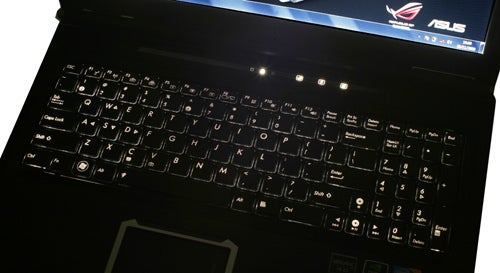
Overall then the G60J will play most titles at medium if not high detail levels on its screen’s relatively low native resolution. As we’ve often said though, if you get the chance to go for a configuration with a much slower (even a lowly Core 2 Duo) processor yet better graphics setup then you should, unless you intend to do a lot of CPU-intensive tasks like video encoding.
Getting back into positive mode Asus has apparently decided that for a laptop such as this nothing less than the 64-bit version of Windows 7 Ultimate will do, which as its title suggests is the best Microsoft OS money can buy. Over the Home Premium version found on most machines you get: Windows XP Mode, Backup and Restore to Networks, full file and drive encryption plus Bit-Locker anti-theft, the ability to switch between 35 languages, location-aware printing and virtual hard disk booting.
Asus also makes sure that from the moment you start this laptop up you know you’re dealing with a gaming machine here (just in case the chassis and price weren’t enough to convince you), as the BIOS splash screen showing off the Republic for Gamers logo is accompanied by the sound of an explosion. Boom, baby!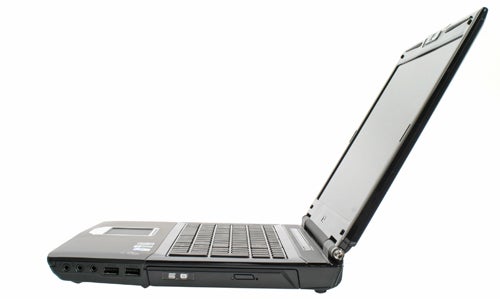
Despite a fairly high-capacity nine-cell (4,800mAh, 53Watt-hour) battery, as with most gaming laptops the G60J won’t survive for long away from a mains socket. MobileMark’s Productivity test wouldn’t complete a single run, while running a DVD (albeit at full screen brightness) killed the machine after a mere 53 minutes.
If it’s any consolation, turning down the screen brightness and configuring Asus’ Power4Gear application should allow you to get well over an hour out if it, and poor battery life is an unfortunate disadvantage of nearly all mobile machines powerful enough to play games. The innovative Asus UL50Vg is one of the few exceptions, but it’s far too weak to be classified as a real gaming laptop. 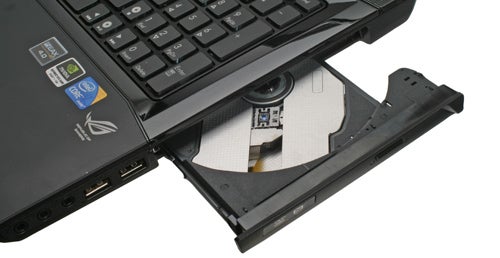
So how does the £1540 G60J compare? Thanks to its Core i7 CPU, the only direct competitor we’ve reviewed is Novatech’s X70 CA Pro, which comes in at £1635. For the extra £95 you do get a superior GTX280 graphics card and Full HD screen, so usually we wouldn’t even hesitate in recommending it over the Asus. However, you also get a chassis that’s not without its faults (including the rubbish keyboard and touchpad buttons) and lose out on the EAX HD 4 sound card, backlit keyboard and twin hard drive configuration. In addition you get Windows 7 Premium instead of Ultimate.
Throw in Asus’ longer warranty and the choice is really up to you, depending on whether you’re happy to use external peripherals with the Novatech and can actually afford the £95. Also keep in mind that at native screen resolutions, the G60J’s GTX 260M can actually run games like Crysis at a better frame rate than the X70 CA Pro’s GTX 280M, arguably giving you a better experience. As for the likes of Alienware, you’ll pay £1625 for a similar configuration except with only a single 500GB hard drive, so in that scenario Asus is the clear winner.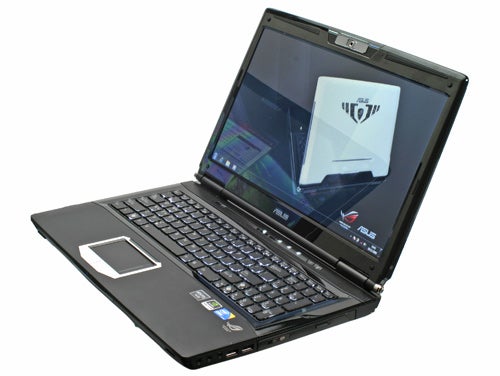
Verdict
To get good gaming performance on a laptop you still need to go for an SLI setup which limits you to Intel’s Core 2, but if you’re after one of the new Core i7 laptops that will at least let you at least play the latest games, the Asus G60J is definitely worth considering.
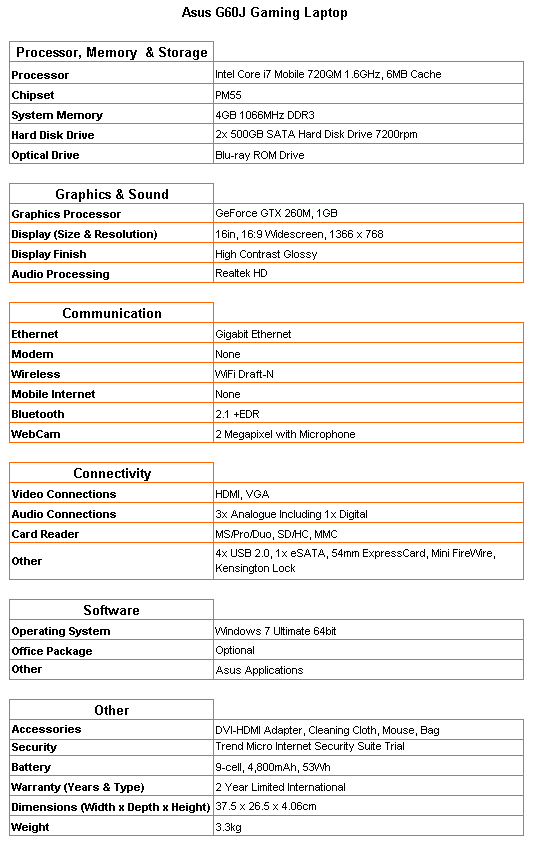
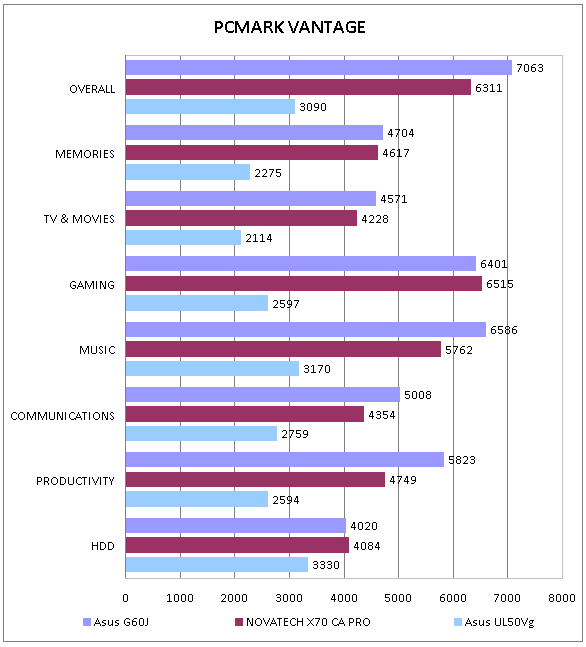
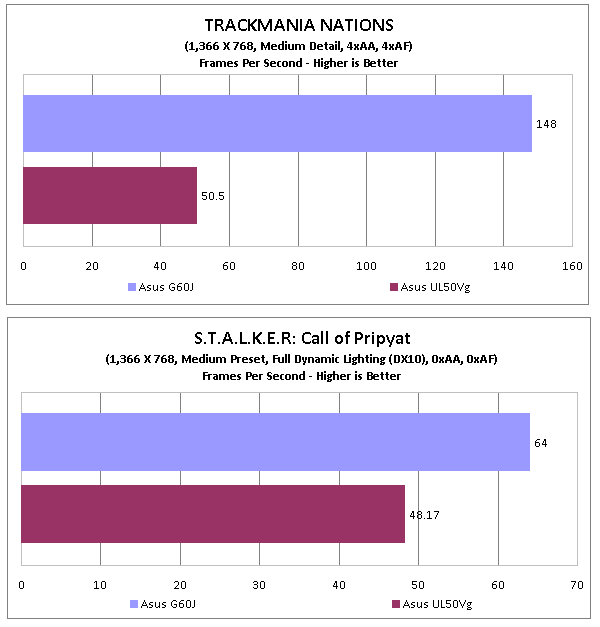
In the TrackMania benchmark we have the G0j6’s GTX260 tripling the performance of the GT230 found in the UL50Vg, showing the difference between a gaming and non-gaming card.
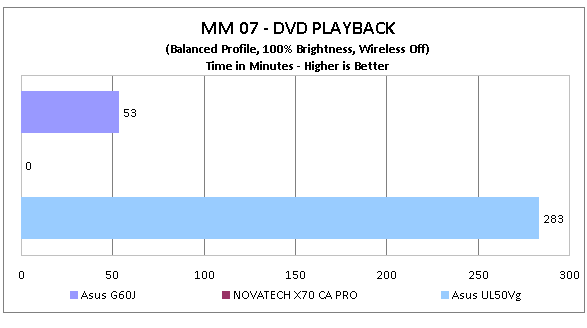
Both of the gaming laptops failed to complete a full run of MobileMark’s Productivity benchmark, but the Asus was the only one of the two to complete the DVD-test, making it clearly superior and meaning you can expect well over an hour of less intensive mobile use.
How we test laptops
Unlike other sites, we test every laptop we review thoroughly over an extended period of time. We use industry standard tests to compare features properly. We’ll always tell you what we find. We never, ever, accept money to review a product.
Trusted Score
Score in detail
-
Performance 8
-
Design 8
-
Value 8
-
Features 9
-
Battery Life 4

